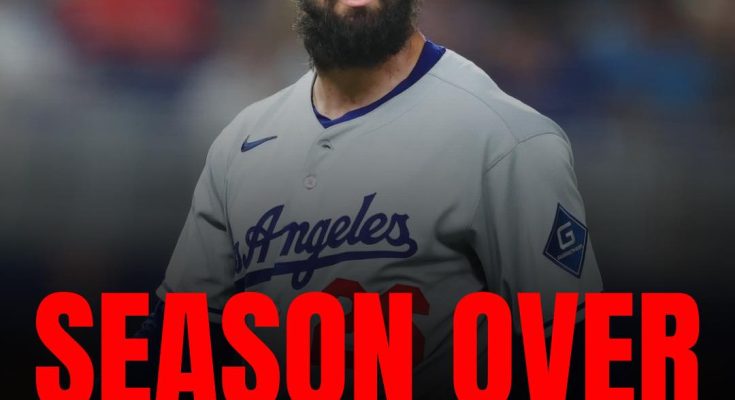Tony Gonsolin’s journey back to pitching for the Los Angeles Dodgers after undergoing Tommy John surgery is a testament to his resilience, determination, and unyielding work ethic. For any professional athlete, especially a pitcher in Major League Baseball, undergoing such a significant surgical procedure can be a career-altering event. It demands not only physical rehabilitation but also mental toughness, patience, and a deep commitment to return to peak performance. Tony Gonsolin’s story exemplifies these qualities in the most profound way.
When a pitcher undergoes Tommy John surgery, it means that the ulnar collateral ligament (UCL) in their elbow has been damaged to the extent that it can no longer support the stresses of pitching. This ligament is crucial because it stabilizes the elbow joint during the intense and repetitive motions of throwing a baseball at high velocity. The surgery involves reconstructing this ligament, typically using a tendon from elsewhere in the body, such as the forearm or hamstring. Although the surgery has a relatively high success rate compared to other orthopedic procedures, the recovery process is lengthy and grueling, often spanning 12 to 18 months before a pitcher can return to competitive play.
For Gonsolin, the road to surgery came after a season where he had begun to establish himself as a key contributor for the Dodgers’ pitching staff. Known for his versatility and ability to perform in various roles—whether starting or relieving—he quickly became an invaluable part of the team’s plans. However, the injury disrupted this trajectory, forcing him to step away from the game he loved and start the painstaking process of recovery.
The initial phase following surgery was probably the most mentally challenging. For a professional athlete, the sudden loss of the ability to compete and contribute to their team can feel like losing a part of their identity. Gonsolin, like many pitchers recovering from Tommy John surgery, had to shift his focus from competition to rehabilitation. This shift requires immense mental strength because progress is measured in small increments—gaining range of motion, rebuilding muscle strength, and gradually reintroducing throwing motions—rather than the immediate results and accolades an athlete is accustomed to.
Throughout this period, Gonsolin would have worked closely with a team of medical professionals, including orthopedic surgeons, physical therapists, athletic trainers, and strength and conditioning coaches. Each stage of recovery has specific milestones, and careful monitoring ensures that the elbow heals correctly and that no setbacks occur. The rehabilitation protocol is meticulous, balancing the need to protect the healing ligament while preventing muscle atrophy and joint stiffness. For Gonsolin, this meant countless hours of physical therapy exercises focused on regaining flexibility and strength in his arm, shoulder, and the surrounding muscles.
But physical recovery is only part of the story. The psychological aspect of returning from such an injury is equally important. Pitchers often grapple with fears about re-injury or doubts about whether they can regain their previous velocity and command. Tony Gonsolin had to confront these doubts head-on. Confidence is essential for pitchers, who rely not only on their physical skills but also on their mental acuity to outthink hitters and maintain composure under pressure. By working through mental barriers and trusting in his rehabilitation, Gonsolin demonstrated remarkable resilience.
In addition to physical and mental rehabilitation, staying connected to the game and his teammates was crucial for Gonsolin. Being away from the mound and the clubhouse can be isolating, but maintaining that connection provides motivation and a sense of purpose. Gonsolin remained engaged with the Dodgers organization, learning from coaches and fellow players, studying hitters, and refining his pitching mechanics. This commitment to staying mentally sharp and involved helped prepare him for the eventual return.
After months of hard work and perseverance, Gonsolin began to progress to throwing off a mound, gradually increasing intensity and pitch counts. This step is critical because it simulates game-like conditions and tests the elbow’s ability to handle the stresses of pitching. For many players, this phase can be both exhilarating and nerve-wracking. Every pitch thrown serves as a checkpoint on the road back to full competition.
When Gonsolin finally returned to game action, it was clear that he had not only physically recovered but also maintained the competitive edge that made him a valuable pitcher before the injury. His pitching arsenal—comprising a sharp fastball, a devastating slider, and a changeup that keeps hitters off balance—remained effective. However, what truly stood out was his mental toughness and maturity on the mound, traits that had been sharpened during his time away from the game.
Gonsolin’s return was a significant boost for the Dodgers, who rely heavily on a strong pitching staff to compete at the highest level. His ability to pitch in various roles gives the team flexibility in managing workloads and matchups. Moreover, his comeback serves as an inspiring example to teammates and fans alike, showing that dedication and hard work can overcome even the toughest obstacles.
In the grander scheme of things, Tony Gonsolin’s experience is reflective of the broader reality faced by many pitchers in professional baseball. Tommy John surgery has become a common but serious challenge, and each successful recovery adds to the body of knowledge on how best to rehabilitate pitchers. Gonsolin’s approach—marked by patience, persistence, and a team-oriented mindset—embodies the best practices in returning from this surgery.
Beyond his personal achievement, Gonsolin’s journey highlights the importance of support systems for injured athletes. From medical staff to family, coaches, and teammates, a network of encouragement and expertise plays a vital role in helping players navigate the uncertainties of injury and recovery. Gonsolin’s ability to lean on this support while maintaining his internal drive was crucial to his successful return.
In conclusion, Tony Gonsolin’s comeback after Tommy John surgery is not just a story about an athlete recovering from injury—it is a powerful narrative of resilience, dedication, and the relentless pursuit of excellence. It showcases how an individual can overcome adversity through disciplined effort and mental strength. For the Los Angeles Dodgers and their fans, Gonsolin’s return to the mound is a cause for celebration and a hopeful reminder of what can be achieved through hard work and belief in oneself. His journey will continue to inspire many young pitchers who face similar challenges, proving that with the right mindset and support, it is possible to return stronger than ever.



